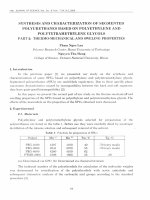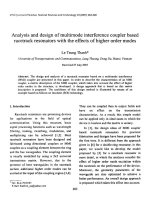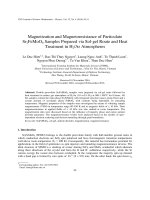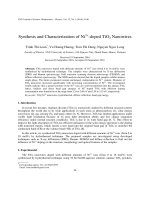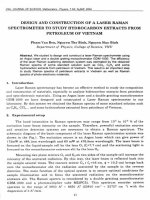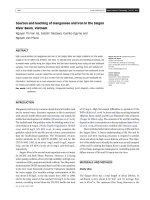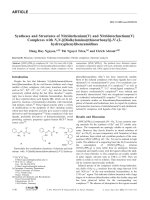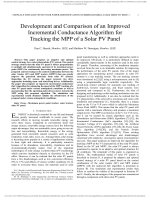DSpace at VNU: Mechanism and Kinetics of Low-Temperature Oxidation of a Biodiesel Surrogate: Methyl Propanoate Radicals with Oxygen Molecule
Bạn đang xem bản rút gọn của tài liệu. Xem và tải ngay bản đầy đủ của tài liệu tại đây (2.22 MB, 45 trang )
Subscriber access provided by UNIV OF CONNECTICUT
Article
Mechanism and Kinetics of Low-temperature Oxidation of a Biodiesel
Surrogate - Methyl Propanoate Radicals with Oxygen Molecule
Xuan T. Le, Tam V.-T. Mai, Artur Ratkiewicz, and Lam K Huynh
J. Phys. Chem. A, Just Accepted Manuscript • DOI: 10.1021/jp5128282 • Publication Date (Web): 30 Mar 2015
Downloaded from on April 2, 2015
Just Accepted
“Just Accepted” manuscripts have been peer-reviewed and accepted for publication. They are posted
online prior to technical editing, formatting for publication and author proofing. The American Chemical
Society provides “Just Accepted” as a free service to the research community to expedite the
dissemination of scientific material as soon as possible after acceptance. “Just Accepted” manuscripts
appear in full in PDF format accompanied by an HTML abstract. “Just Accepted” manuscripts have been
fully peer reviewed, but should not be considered the official version of record. They are accessible to all
readers and citable by the Digital Object Identifier (DOI®). “Just Accepted” is an optional service offered
to authors. Therefore, the “Just Accepted” Web site may not include all articles that will be published
in the journal. After a manuscript is technically edited and formatted, it will be removed from the “Just
Accepted” Web site and published as an ASAP article. Note that technical editing may introduce minor
changes to the manuscript text and/or graphics which could affect content, and all legal disclaimers
and ethical guidelines that apply to the journal pertain. ACS cannot be held responsible for errors
or consequences arising from the use of information contained in these “Just Accepted” manuscripts.
The Journal of Physical Chemistry A is published by the American Chemical Society.
1155 Sixteenth Street N.W., Washington, DC 20036
Published by American Chemical Society. Copyright © American Chemical Society.
However, no copyright claim is made to original U.S. Government works, or works
produced by employees of any Commonwealth realm Crown government in the course
of their duties.
Page 1 of 44
1
2
3
4
5
6
7
8
9
10
11
12
13
14
15
16
17
18
19
20
21
22
23
24
25
26
27
28
29
30
31
32
33
34
35
36
37
38
39
40
41
42
43
44
45
46
47
48
49
50
51
52
53
54
55
56
57
58
59
60
The Journal of Physical Chemistry
Mechanism and Kinetics of Low-Temperature Oxidation of a Biodiesel Surrogate Methyl Propanoate Radicals with Oxygen Molecule
Xuan T. Le,a Tam V.T Mai,a Artur Ratkiewiczb and Lam K. Huynha,c*
a
b
Institute for Computational Science and Technology at Ho Chi Minh City;
Institute of Chemistry, University of Bialystok, ul Hurtowa 1 15-399 Białystok Poland
c
International University, Vietnam National University - HCMC
------*
Corresponding authors. Email address: / (LKH)
Tel: (84-8) 2211.4046 (Ext. 3233) Fax: (84-8) 3724.4271
Graphical Abstract
1
ACS Paragon Plus Environment
The Journal of Physical Chemistry
1
2
3
4
5
6
7
8
9
10
11
12
13
14
15
16
17
18
19
20
21
22
23
24
25
26
27
28
29
30
31
32
33
34
35
36
37
38
39
40
41
42
43
44
45
46
47
48
49
50
51
52
53
54
55
56
57
58
59
60
Page 2 of 44
Abstract
This paper presents a computational study on the low-temperature mechanism
and kinetics of the reaction between molecular oxygen and alkyl radicals of methyl
propanoate (MP), which plays an important role in low-temperature oxidation and/or
auto-ignition processes of the title fuel. Their multiple reaction pathways either
accelerate the oxidation process via chain branching or inhibit it by forming relatively
stable products. The potential energy surfaces of the reactions between three primary
MP radicals and molecular oxygen, namely, C•H2CH2COOCH3 + O2, CH3C•HCOOCH3
+ O2 and CH3CH2COOC•H2 + O2, were constructed using the accurate composite CBSQB3 method. Thermodynamic properties of all species as well as high-pressure rate
constants of all reaction channels were derived with explicit corrections for tunneling
and hindered internal rotations. Our calculation results are in good agreement with a
limited number of scattered data in the literature. Furthermore, pressure- and
temperature-dependent rate constants for all reaction channels on the multiwellmultichannel potential energy surfaces were computed with the Quantum Rice–
Ramsperger–Kassel (QRRK) and the modified strong collision (MSC) theories. This
procedure resulted in a thermodynamically-consistent detailed kinetic sub-mechanism
for low-temperature oxidation governed by the title process. A simplified mechanism,
which consists of important reactions, is also suggested for low-temperature combustion
at engine-liked conditions.
Keywords: biodiesel surrogate, methyl propanoate, pressure-dependent rate constants,
low-temperature oxidation, thermodynamics and detailed kinetic mechanism.
2
ACS Paragon Plus Environment
Page 3 of 44
1
2
3
4
5
6
7
8
9
10
11
12
13
14
15
16
17
18
19
20
21
22
23
24
25
26
27
28
29
30
31
32
33
34
35
36
37
38
39
40
41
42
43
44
45
46
47
48
49
50
51
52
53
54
55
56
57
58
59
60
The Journal of Physical Chemistry
1. Introduction
Biodiesel fuels are often produced from mono-alkyl esters of long-chain fatty
acids derived from vegetable oils and animal fats. Typically, they have the structure of a
methyl ester group attached to a long hydrocarbon chain of about 16-19 carbon atoms
(C16-19Hx-C(=O)O-CH3). Due to the presence of the heterogeneous oxygen atom as in
the ester functional group (–COO–), compared to the traditional hydrocarbon fuels,
their physical and chemical properties/behaviors are expected to be different.
Specifically, it is a more environmentally-friendly fuel with low emission of pollutants
such as carbon monoxide, carbon dioxide, sulfur compounds and particulate matter,1
while its effects on nitrogen oxides (NOx) remain uncertain. Such NOx emissions have
been experimentally observed either increasingly2, 3 or decreasingly4 with the use of
biodiesel as an alternative fuel or a blend component. Therefore, there is a need for
further investigation to shed more light on benefits, drawbacks of biodiesel fuels as well
as its influence on operational conditions of engines so that we can take full advantage
of this type of alternative fuels.
However, due to their large size and chemical/physical complexity, detailed
kinetic study on these biodiesel molecules is very challenging both experimentally and
computationally. To meet these challenges, simple molecules referred to as surrogates
are normally used to emulate the physical and chemical properties of real conventional
fuels that are too complicated for detailed investigation. Computationally, an effective
approach is to study small surrogate systems with accurate methods and then
extrapolate the known chemistry/physics to larger systems (if applicable) in terms of
structure-based rate constant relationship (or rate rules).5-7 Once those rate rules are
established, they can be used to construct the detailed kinetic mechanism for larger real
systems using available automatic reaction mechanism generating software.8-14
3
ACS Paragon Plus Environment
The Journal of Physical Chemistry
1
2
3
4
5
6
7
8
9
10
11
12
13
14
15
16
17
18
19
20
21
22
23
24
25
26
27
28
29
30
31
32
33
34
35
36
37
38
39
40
41
42
43
44
45
46
47
48
49
50
51
52
53
54
55
56
57
58
59
60
Page 4 of 44
Therefore, it is necessary to determine optimal surrogate models which are small
enough to be investigated using accurate calculations but also large enough to represent
the chemistry/physics of real molecules. Such good surrogate models will allow us to
investigate the oxidation of real methyl esters in an internal combustion engine.15-22 In
this context, methyl propanoate (MP) was chosen for such purposes. It is worth noting
that MP radicals were found to be a cracking intermediate/product with relatively high
concentrations in the pyrolysis of biodiesel such as the rapeseed methyl ester (RME);23
therefore, understanding of the oxidation mechanism and kinetics of MP will
significantly contribute to the development of reliable kinetic models for larger methyl
esters and biodiesels.24
The focus of this study is to provide first-principles based kinetic data for
characterizing of MP radicals + O2 reactions which, like in the analogous alkyl systems,
are believed to play an important role in low-temperature oxidation and auto-ignition
processes.16 Based on the well-constructed potential energy surfaces (PESs) explored at
the high-level composite method CBS-QB3, the detailed kinetic analysis is carried out
to investigate the kinetic behavior of this system in low-temperature combustion
conditions. In order to achieve accurate kinetic predictions of complex chemical
systems, it is necessary to incorporate pressure dependence into kinetic models. This is
done under the framework of the Quantum Rice-Ramsperger-Kassel (QRRK) and the
modified strong collision (MSC) theories.25 The detailed kinetic mechanism for the title
reaction, MP radicals + O2, is then compiled in the CHEMKIN format for a wide range
of temperatures and pressures. A simplified mechanism, which consists of only the
most important reactions, is also suggested for low-temperature combustion at engineliked conditions.
4
ACS Paragon Plus Environment
Page 5 of 44
1
2
3
4
5
6
7
8
9
10
11
12
13
14
15
16
17
18
19
20
21
22
23
24
25
26
27
28
29
30
31
32
33
34
35
36
37
38
39
40
41
42
43
44
45
46
47
48
49
50
51
52
53
54
55
56
57
58
59
60
The Journal of Physical Chemistry
2. Computational Details
2.1. Electronic Structure Calculations
The electronic structure calculations were carried out using the GAUSSIAN
0926 program. Among different correlated methods considered available, the composite
method CBS-QB3,27 which was previously validated for its ability to accurate predict
PES data for the analogous alkyl + O2 systems,28, 29 is expected to be the method of
choice in terms of accuracy and computation time. This method was successfully used
to study thermodynamics and kinetics of similar and larger oxygenated systems. For
example, it was applied to investigate methyl-ester peroxy radical decomposition in the
low-temperature oxidation of methyl butanoate.30 CBS-QB3 data were also used to
derive group additive values for different oxygenated compounds31-33; bond dissociation
energies and enthalpies of formation of methyl/ethyl butanoate;34 oxidation of methyl
and ethyl butanoates;35 and abstraction reaction between MP and hydroxyl radical36 in
which CBS-QB3 is the method of choice to refine the energy for the BH&HLYP and
MP2 geometries. A good agreement on calculated reaction barriers and energies for
several important reactions was also observed with those by other methods, namely G3,
G3B3 and G4 (cf. see Supplementary Table S2).
All reported results for stable molecules as well as transition states (first-order
saddle points on the PESs) were obtained with the lowest-energy conformer of a given
species. Normal-mode analysis was performed to verify the nature of each of these
stationary points. For complicated reaction pathways, in order to confirm the correct
transition state, the minimum energy paths (MEP) from the transition state to both the
reactants to products were calculated using the intrinsic reaction path (IRC) following
method.37, 38
5
ACS Paragon Plus Environment
The Journal of Physical Chemistry
1
2
3
4
5
6
7
8
9
10
11
12
13
14
15
16
17
18
19
20
21
22
23
24
25
26
27
28
29
30
31
32
33
34
35
36
37
38
39
40
41
42
43
44
45
46
47
48
49
50
51
52
53
54
55
56
57
58
59
60
Page 6 of 44
2.2. Thermodynamic Property Calculations
The atomization method was employed to calculate the heats of formation of all
species and standard statistical mechanics methods were used to calculate
thermodynamic properties such as entropies and heat capacities. Because only relative
energies are required in this work, no attempts were made to improve the heats of
formation using, for example, bond additivity corrections. All harmonic frequencies
were scaled by a factor of 0.99 as recommended by Petersson and coworkers27 prior to
their use. It has been shown that the use of the scale factor of 0.99 gives reliable results,
for both enthalpy and entropy, for similar methyl acetate (MA) radical + O2 system.39
Some low-frequency vibrational modes, which are better treated as internal rotations
around single bonds, were replaced in the thermodynamic calculations by an explicit
evaluation of the hindered rotations in the most accurate manner as described in our
previous work.39
2.3. Rate Constant Calculations
The high-pressure rate constants for elementary reactions were calculated using
canonical transition state theory (TST) with tunneling corrections based on asymmetric
Eckart potentials.40 Pressure- and temperature- dependent rates for the multiwellmultichannel PES were calculated based on a steady-state analysis, in which the energydependent unimolecular rate coefficients k(E) were computed using the QRRK theory.25
The vibrational frequencies needed to calculate the density of states were extracted
from the analysis of the heat capacities, obtained from the CBS-QB3 data. Collisional
stabilization rate constants were calculated using the modified strong collision
assumption (MSC).25 The high-pressure kinetic data for the barrierless recombination of
MP radicals with O2 were derived from similar data for alkyl + O2 systems.28, 29 In the
same vein, the Lennard-Jones collision diameters ( σ LJ ) of 6.205 Å and well depths
6
ACS Paragon Plus Environment
Page 7 of 44
1
2
3
4
5
6
7
8
9
10
11
12
13
14
15
16
17
18
19
20
21
22
23
24
25
26
27
28
29
30
31
32
33
34
35
36
37
38
39
40
41
42
43
44
45
46
47
48
49
50
51
52
53
54
55
56
57
58
59
60
The Journal of Physical Chemistry
( ε LJ ) of 721.3 K were estimated from similar systems.41 To calculate stabilization rate
constants the average energy transferred per collision Eall = 440 cal/mol28 for the bath
gas collider of N2 ( σ LJ = 3.80 Å , ε LJ = 71.4 K )41 was assumed. The calculations were
also performed with He as the bath gas ( Eall = 250 cal/mol;28 σ LJ = 2.55 Å and
ε LJ = 10.2 K 41). The simulation results (provided in the accompanied Supplementary
material) were generally found to be rather insensitive to the nature of the collider, at
least for the conditions considered in this study.
3. Results and Discussion
In the section below, we first report the CBS-QB3 potential energy surfaces
(PESs) of the reactions between molecular oxygen with the three primary MP radicals,
namely
•CH2CH2C(=O)OCH3
(R1),
CH3C•HC(=O)OCH3
(R2)
and
CH3CH2C(=O)OC•H2 (R3). The appropriate pathways are then discussed to highlight
important channels energetically. Furthermore, thermodynamic properties of all species
as well as high-pressure rate constants of all reaction channels with explicit corrections
for tunneling and hindered internal rotations are derived and compared with literature
data. The pressure-dependent analysis is carried out within the QRRK/RRKM
framework. This analysis results in a thermodynamically consistent detailed kinetic
mechanism for low-temperature oxidation of the title reactions. In addition, important
reactions at the conditions of interest (e.g., engine-liked conditions) are identified,
which opens the possibility to derive rate rules to larger similar systems.
The three primary MP radicals can isomerize to each other through the
hydrogen migration reactions via different ring transition states (cf. Figure 1) whose
barriers depend on the reaction type. As discussed in the literature42, the barrier heights
7
ACS Paragon Plus Environment
The Journal of Physical Chemistry
1
2
3
4
5
6
7
8
9
10
11
12
13
14
15
16
17
18
19
20
21
22
23
24
25
26
27
28
29
30
31
32
33
34
35
36
37
38
39
40
41
42
43
44
45
46
47
48
49
50
51
52
53
54
55
56
57
58
59
60
Page 8 of 44
increase as the size of the ring in the transition states decrease. The same trend,
confirmed further in this study, is also true for the reverse reactions.
Figure 1. Three MP radicals formed by breaking C – H bond: (a) 3-methoxy-3oxopropyl,
•CH2CH2C(=O)OCH3
(R1);
(b)
1-methoxy-1-oxopropan-2-yl,
CH3C•HC(=O)OCH3 (R2); (c) propanoyloxy methyl, CH3CH2C(=O)OC•H2 (R3). The
symbol “•” is denoted the radical position. These radicals can isomerize through
hydrogen migration reactions whose transition states are given below and above the
reversible arrows.
3.1. Potential Energy Surfaces
Formation/stabilization of initially-formed adducts ROO••. This reaction is the main
channel of the complex process, governing the low-temperature fuel behavior. The
strength of the formed C-OO bond in the alkyl peroxy radicals (or the ROO• well depth)
determines the importance of the collisional stabilization channel and the temperature
and pressure at which this reaction plays a role. Re-dissociation of ROO• is believed to
be the main cause of the negative-temperature coefficient (NTC) effect.43 Due to the
presence of the ester group –C(=O)O–, it is expected that the behavior of biodiesel
surrogates, including the methyl propanoate studied here, is different from that of the
analogous alkyl systems.
8
ACS Paragon Plus Environment
Page 9 of 44
1
2
3
4
5
6
7
8
9
10
11
12
13
14
15
16
17
18
19
20
21
22
23
24
25
26
27
28
29
30
31
32
33
34
35
36
37
38
39
40
41
42
43
44
45
46
47
48
49
50
51
52
53
54
55
56
57
58
59
60
The Journal of Physical Chemistry
The
C-OO
bond
energy
at
298
K
increases
in
the
order
of
CH3HC(OO•)C(=O)OCH3, CH3CH2C(=O)OCH2OO• and •OOCH2CH3C(=O)OCH3
(25.5, 34.3 and 34.9 kcal/mol, respectively). It is noted that for the methyl acetate
radicals, the values are 25.5 and 33.9 kcal/mol for •OOCH2C(=O)OCH3 and
CH3C(=O)OCH2OO•, respectively,39 and the numbers are 35.6 and 37.4 kcal/mol for
general primary and secondary carbon sites, respectively.5, 44 The difference in the C—
OO bond energy between the two systems (i.e., methyl ester alkyl and alkyl, suggest
that the ester group has significant effect on the nearest radical site connected to the
ester carbon (e.g., at •CH2C(=O)OCH3 and CH3C•HC(=O)OCH3). This observation can
be explained in terms of the hyper-conjugation effect as discussed for methyl acetate
radicals + O2 system39 and for similar alkyl + O2 systems.5, 44, 45
Figures 2-4 present the PESs at 0 K for the three systems established at the
CBS-QB3 level. Because of the large number of propagation reactions involved,
unimportant pathways (i.e., having the barrier higher than 12 kcal/mol above the
entrance channel) are not included. Optimized geometries of all species with important
geometrical parameters at the CBS-QB3 level are provided in Supplementary Table S7.
Detailed molecular information of the involved species can be found in Supplementary
Table S7. To facilitate the discussion, the CBS-QB3 energies at 0 K are used
universally and are cited relatively to the reactant energy; otherwise, it is explicitly
stated.
•CH2CH2C(=O)OCH3 + O2 system.
Figure 2 shows the calculated CBS-QB3 potential energy diagram for the
•CH2CH2C(=O)OCH3
+
O2
system
at
0
K.
The
initially-formed
adduct
•OOCH2CH2C(=O)OCH3 (I1) can react through several reaction pathways, namely, redissociation back to the reactant, isomerization to different intermediates, or
9
ACS Paragon Plus Environment
The Journal of Physical Chemistry
1
2
3
4
5
6
7
8
9
10
11
12
13
14
15
16
17
18
19
20
21
22
23
24
25
26
27
28
29
30
31
32
33
34
35
36
37
38
39
40
41
42
43
44
45
46
47
48
49
50
51
52
53
54
55
56
57
58
59
60
Page 10 of 44
dissociation to different bimolecular products. The lowest energy channel is to form
methyl acrylate through the concerted HO2 elimination reaction (P3 channel), which
proceeds via a planar five-membered ring transition state (TS1) with the barrier height
of 27.1 kcal/mol (6.9 kcal/mol below the entrance channel). Due to the effect of the
ester group, the barrier of this channel is about 3 kcal/mol lower than those at the same
primary carbon of the alkyl systems (e.g., 30.9 and 29.7 kcal/mol for n-propyl radical
by Huynh et al.29 and DeSain et al.,46 respectively). This low-energy channel is
expected to play a role at the low temperature and/or high pressure.
Alternatively, I1 can form methyl 3-oxopropanoate (O=CHCH2C(=O)OCH3)
and OH (P1 products) through the 1-3s H-transfer transition state (TS2) with barrier
energy of 41.7 kcal/mol (7.7 kcal/mol above the entrance channel). The H-transfer
notation refers to the position of the heavy atoms involved in the transition state and the
type of radical produced (e.g., primary, secondary or tertiary) which was adopted from
the
work
of
Goldsmith
(HOOC•HCH2C(=O)OCH3)
and
is
coworkers.47
unstable;
thus
The
it
can
isomerization
easily
product
dissociate
to
O=CHCH2C(=O)OCH3 and OH. The adduct I1 can also isomerize to form two isomers,
namely, HOOCH2C•HC(=O)OCH3 (I2) and HOOCH2CH2C(=O)OC•H2 (I3). I2 can
dissociate to form bimolecular products such as methyl acrylate + HO2 via TS8 (βscission reaction) and methyl oxirane-2-carboxylate (cy[H2COCH]CC(=O)OCH3) +
OH via TS6 (cyclization reaction) with the barrier, ∆V ≠ , of 18.3 kcal/mol and 17.6
kcal/mol, respectively. Even though I2 is more stable; I3 can be formed easier from I1
since it proceeds via 1-7p H-migration with eight-membered ring transition state (TS4
with ∆V ≠ = 27.8 kcal/mol) compared to 1-4s H-migration with five-member ring
transition state (TS3 with ∆V ≠ = 33.2 kcal/mol). I3 can also be formed from I2 through
TS5 with a much higher barrier than the formation of I5 via TS7, with barrier of 23.9
10
ACS Paragon Plus Environment
Page 11 of 44
1
2
3
4
5
6
7
8
9
10
11
12
13
14
15
16
17
18
19
20
21
22
23
24
25
26
27
28
29
30
31
32
33
34
35
36
37
38
39
40
41
42
43
44
45
46
47
48
49
50
51
52
53
54
55
56
57
58
59
60
The Journal of Physical Chemistry
kcal/mol. This intermediate can isomerize to form •OCH2CH2C(=O)OCH2OH (I6)
lying at 75.9 kcal/mol below the entrance channel via 1-6 OH transfer reaction (TS9)
with barrier height of 19.2 kcal/mol. Alternatively, this intermediate can form
HOOCH2CH2C•=O (I4) + formaldehyde (at 1.8 kcal/mol) via β-scission reaction TS10
( ∆V ≠ = 31.0 kcal/mol) and the 1,3-dioxan-4-one (cy[CH2CH2C(=O)OCH2O]) + OH (56.1 kcal/mol) though the cyclization reaction via TS11 ( ∆V ≠ = 21.1 kcal/mol).
The potential energy diagram for the •CH2CH2C(=O)OCH3 + O2 system is very
complicated with 03 wells/intermediates and many interconnecting channels. The
formation of the initially-formed adduct is the first and the most important event for the
evolution of the system. Among all possible reactions of the adduct I1, the dissociation
back to the reactants and the concerted HO2 elimination dominate the isomerization
channels; therefore, the subsequent reactions of isomerization products seem to be of
little importance. The kinetic analysis presented further in this study confirms this
expectation.
11
ACS Paragon Plus Environment
The Journal of Physical Chemistry
1
2
3
4
5
6
7
8
9
10
11
12
13
14
15
16
17
18
19
20
21
22
23
24
25
26
27
28
29
30
31
32
33
34
35
36
37
38
39
40
41
42
43
44
45
46
47
48
Page 12 of 44
Figure 2. Potential energy diagram for the •CH2CH2C(=O)OCH3 + O2 system at 0 K, calculated at the composite CBS-QB3 level. Numbers are
the energies relative to that of the reactants and channels (having energy higher than 12 kcal/mol above the entrance channel) are not included.
Hydrogen is not explicitly given in the molecular formula for simplicity, unless it involves in the considered reactions and/or it is for clarity.
12
ACS Paragon Plus Environment
Page 13 of 44
1
2
3
4
5
6
7
8
9
10
11
12
13
14
15
16
17
18
19
20
21
22
23
24
25
26
27
28
29
30
31
32
33
34
35
36
37
38
39
40
41
42
43
44
45
46
47
48
49
50
51
52
53
54
55
56
57
58
59
60
The Journal of Physical Chemistry
CH3C••HC(=O)OCH3 + O2 system
A simplified scheme of the reaction network starting from CH3C•HC(=O)OCH3
is presented in Figure 3. Similar to the first system, the formation of the initial-adduct
radical, CH3HC(OO•)C(=O)OCH3 (I8), is a barrierless process with a smaller welldepth (24.9 vs. 34.0 kcal/mol for I8 and I1, respectively); thus it is expected that the
effect of the ester group is more profound at this system. The adduct I8 can form methyl
acrylate through concerted HO2 elimination reaction via TS15 with the barrier of 27.2
kcal/mol (2.3 kcal/mol above the entrance channel) which is smaller than that of ipropyl system ( ∆V ≠ = 31.2 kcal/mol29), thus it is expected to be the dominant pathway
to form methyl acrylate and HO2. In addition to the concerted channel, adduct I8 can
proceed through two isomerization channels: H atom transfer from a methyl group to
the
peroxy
radical
site
via
a
seven-member
CH3HC(OOH)C(=O)OC•H2
(I9)
and
via
a
ring
(TS13)
five-member
ring
to
form
(TS14)
to
•CH2HC(OOH)C(=O)OCH3 (I10) with the barrier of 30.5 and 36.2 kcal/mol,
respectively. The former isomer can dissociate to two bimolecualr products, where the
formation of the cyclic CH3cy[HCC(=O)OCH2O] (P6) via TS17 has the barrier of 4.5
kcal/mol smaller than that of CH3C(=O)C(=O)OCH3 (P5) via TS16 (through H atom
transfer from a secondary site to methyl group). The latter isomer can contribute to the
formation of methyl acrylate through β-scission reaction (TS19) with the barrier of 0.5
kcal/mol lower than that of the channel to methyl oxirane-2-carboxylate
(cy[H2COCH]C(=O)OCH3) through cyclization reaction (TS18).
13
ACS Paragon Plus Environment
The Journal of Physical Chemistry
1
2
3
4
5
6
7
8
9
10
11
12
13
14
15
16
17
18
19
20
21
22
23
24
25
26
27
28
29
30
31
32
33
34
35
36
37
38
39
40
41
42
43
44
45
46
47
48
Page 14 of 44
Figure 3. Potential energy diagram for the CH3C•HC(=O)OCH3 + O2 system at 0 K, calculated at the composite CBS-QB3 level. Numbers are
the energies relative to that of the reactants and channels (having energy higher than 12 kcal/mol above the entrance channel) are not included.
Hydrogen is not explicitly given in the molecular formula for simplicity, unless it involves in the considered reactions or it is for clarity.
14
ACS Paragon Plus Environment
Page 15 of 44
1
2
3
4
5
6
7
8
9
10
11
12
13
14
15
16
17
18
19
20
21
22
23
24
25
26
27
28
29
30
31
32
33
34
35
36
37
38
39
40
41
42
43
44
45
46
47
48
49
50
51
52
53
54
55
56
57
58
59
60
The Journal of Physical Chemistry
CH3CH2C(=O)OC••H2 + O2 system
This reaction network is expected to be the most complicated among the three
MP radical systems. Figure 4 provides the potential energy surface diagram of this
system where only the channels lower than 12 kcal/mol above the entrance are
described for the sake of simplicity. The adduct CH3CH2C(=O)OCH2OO• (I11) is
initially formed via a barrierless reaction with a well depth of 33.5 kcal/mol and 34.3
kcal/mol at 0 and 298 K, respectively. These values agree well with previous
calculations for the same radical site of methyl acetate + O2 by Mai et al.39 (33.4 and
33.9 kcal/mol at 0 and 298 K respectively) and of methyl butanoate radicals + O2 by
Tao et al.30 (~34 kcal/mol at 0 K), thus demonstrating that the carbon chain length has a
little impact on this radical site. Furthermore, the results for the oxygenated species
agree well with similar calculations for the primary carbon site of the n-propyl + O2
system, (34.8 and 35.5 kcal/mol at 0 and 298 K, respectively). This oxygen centered
radical experiences the internal H abstraction from any of the three possible carbon sites,
one of which is the formation of the stable product (P8) from the unstable
CH3CH2C(=O)O C•(OOH)H via a four-member ring (TS24). Two other channels lead
to reactive intermediates: •CH2CH2C(=O)OCH2OOH (I13) via an eight-membered ring
transition state TS21, and CH3C•HC(=O)OCH2OOH (I12) via seven-membered ring
TS20, about 1 kcal/mol higher than TS21. The difference between those barriers can be
explained mainly through the different strain energies of various TS-ring sizes. The
barrier height of the I11→TS20→I12 channel is equal to 26.7 kcal/mol, which is lower
than those of MA+O239 and MB+O230 about 3.8 and 1.8 kcal/mol, respectively. The
barrier deviation between the MP and MA can be demonstrated by the difference of the
secondary (for MP) and primary (for MA) C-H sites. It is interesting to note that there is
no significant difference between barriers for MP and MB (26.7 and 26.5 kcal/mol,
15
ACS Paragon Plus Environment
The Journal of Physical Chemistry
1
2
3
4
5
6
7
8
9
10
11
12
13
14
15
16
17
18
19
20
21
22
23
24
25
26
27
28
29
30
31
32
33
34
35
36
37
38
39
40
41
42
43
44
45
46
47
48
49
50
51
52
53
54
55
56
57
58
59
60
Page 16 of 44
respectively). Intermediate I12 can dissociate to form several bi-molecular products,
among which is the formation of the cyclic CH3cy[CHC(=O)OCH2O] and aldehyde
(CH3CH2C(=O)OCHO) compounds with the barriers comparable to the entrance
channel (5.7 and 2.5 kcal/mol below the entrance channel, respectively). The 1-5
hydroxide migration reaction from I12 to C H3C(OH)HC(=O)OCH2O• (I14) proceeds
with a barrier higher than those of the other processes involving I12; thus this channel is
expected not to be competitive in the low temperature regime. I13 can be formed from
I11 via TS21 with the barrier of 25.7 kcal/mol, which is in excellent agreement with the
analogical reaction in the MB + O2 system (i.e., the difference is less than 0.5 kcal/mol
at 0 and 298 K).30 Although the formation of I13 has a barrier lower than those of I12,
I13 is less stable than I12 and lies 21.6 kcal/mol below the reactant. As a result, I13 can
easily proceed through four reaction pathways: (1) 1-5s H-atom transfer to form an
unstable CH3CH2C(=O)OC•(OOH)H via a seven-member ring transition state TS25
( ∆V ≠ = 20.5 kcal/mol); (2) 1-6 hydroxide migration to form intermediate
HOCH2CH2C(=O)OCH2O• (I16) via TS28 ( ∆V ≠ = 26.3 kcal/mol); (3) cyclization
reaction to cy[H2CCH2C(=O)OCH2O] via TS29 ( ∆V ≠ = 20.5 kcal/mol) and (4) βscission reaction to intermediate •C(=O)OCH2OOH (I15) via TS30 ( ∆V ≠ = 31.9
kcal/mol). The channels (2) and (4) have the barriers much higher than (1) and (3);
therefore, they are energetically less favorable.
16
ACS Paragon Plus Environment
Page 17 of 44
1
2
3
4
5
6
7
8
9
10
11
12
13
14
15
16
17
18
19
20
21
22
23
24
25
26
27
28
29
30
31
32
33
34
35
36
37
38
39
40
41
42
43
44
45
46
47
48
The Journal of Physical Chemistry
Figure 4. Potential energy diagram for the CH3CH2C(=O)OC•H2 + O2 system at 0 K, calculated at the composite CBS-QB3 level. Numbers are
the energies relative to that of the reactants and channels (having energy higher than 12 kcal/mol above the entrance channel) are not included.
Hydrogen is not explicitly given in the molecular formula for simplicity, unless it involves in the considered reactions or it is for clarity.
17
ACS Paragon Plus Environment
The Journal of Physical Chemistry
1
2
3
4
5
6
7
8
9
10
11
12
13
14
15
16
17
18
19
20
21
22
23
24
25
26
27
28
29
30
31
32
33
34
35
36
37
38
39
40
41
42
43
44
45
46
47
48
49
50
51
52
53
54
55
56
57
58
59
60
Page 18 of 44
3.2. Thermodynamic Properties
Calculations of thermodynamic properties (heat of formation △fH, entropy S and heat
capacity Cp) follow the procedure described in the “Thermodynamic Property Calculations”
section above. The thermodynamic properties of species involved in the MP + O2 systems are
limited in the literature. To evaluate the reliability of our results, we provided the literature
values along with the calculated numbers for selected species (cf. Table 1) while the
calculated data for all species involved can be found in the accompanied supplementary
material. The available experimental/calculated data (from Webbook NIST48 and Active
Thermochemical Tables (ATcT)49,
50
) confirm that our calculated values are within the
uncertainty range for △fH, S and Cp. The mean average deviation (MAD) between our
numbers and ATcT approach are 1.6 kcal/mol for △fH298 K, 1.5 cal/mol-K for S298 K and 0.8
cal/mol-K for Cp298 K, while those for NIST data are 1.4 kcal/mol and 2.83 cal/mol-K for
△fH298
K
and S298 K, respectively. That the average differences in △fH is within chemical
accuracy range (1-2 kcal/mol) give us more confidence in our numbers, which are then used
for the next calculations.
18
ACS Paragon Plus Environment
Page 19 of 44
1
2
3
4
5
6
7
8
9
10
11
12
13
14
15
16
17
18
19
20
21
22
23
24
25
26
27
28
29
30
31
32
33
34
35
36
37
38
39
40
41
42
43
44
45
46
47
48
The Journal of Physical Chemistry
Table 1. Comparison of Calculated Thermodynamic Properties of Selected Stable Species Involved in the System with
Experimental/Calculated Data (ATcT=Active Thermochemical Tables49, 50[a], NIST48 = Webbook NIST). Units: kcal/mol for △fH298and
cal/mol-K for S and Cp.
Species
O=CCC(=O)OC
cy[CCC(=O)OCO]
CC(=O)C(=O)OC
Ccy[CC(=O)OCO]
HOCCC(=O)OH
CCC(=O)OC=O
cy[COC]C(=O)OC
C=CC(=O)OC
CC(OH)C(=O)OH
CCC(=O)OC
C2H4
Method
This work[b]
NIST
This work
NIST
This work
NIST
This work
NIST
This work
NIST
This work
NIST
This work
NIST
This work
ATcT
NIST
This work
ATcT
NIST
This work
ATcT
NIST
This work
∆fH298 [c]
S298
Cp300
Cp400
Cp500
Cp600
Cp800
Cp1000
Cp1500
kcal/mol
-122.3
-125.1
-121.4
91.1
97.6
78.0
27.6
33.0
cal/mol-K
38.0
42.2
48.9
53.7
60.9
–
–
–
–
–
–
–
23.9
30.9
37.1
42.2
50.0
55.4
63.3
–
–
–
–
–
–
–
–
–
-123.5
-121.9
-125.7
90.1
97.9
81.2
28.5
33.7
38.3
42.4
48.8
53.5
60.7
–
–
–
–
–
–
–
25.6
31.8
37.7
42.5
49.9
55.0
62.6
–
–
–
–
–
–
–
–
–
-147.7
-144.4
-135.2
-129.1
-99.1
-99.9
-73.9
-17.7[d]
-74.0
-149.1
-145.8
-148.4
-104.8
-104.5
-103.8
13.2
81.9
87.8
88.8
96.1
87.3
90.8
81.1
86.0
87.4
82.9
84.6
87.0
87.0
89.8
89.3
52.3
25.5
25.3
29.1
32.1
30.7
34.9
37.6
34.9
40.2
42.0
38.5
44.7
48.1
44.3
51.3
52.0
48.3
55.9
57.5
–
62.1
–
–
–
–
–
–
–
26.0
32.4
38.1
42.8
49.7
54.6
61.9
–
–
–
–
–
–
–
24.3
24.3
29.6
29.4
34.5
34.2
38.7
38.3
45.2
44.5
49.7
49.0
56.5
55.4
–
–
–
–
–
–
–
26.4
24.3
25.1
26.2
25.9
32.6
30.1
30.6
31.8
31.5
37.7
35.0
35.4
37.2
37.0
41.7
39.0
39.1
42.0
41.9
47.3
44.8
45.0
49.7
49.6
51.0
48.9
49.0
55.5
55.4
56.5
55.0
–
64.3
63.6
–
–
–
–
–
–
–
10.2
12.5
14.8
16.7
19.8
22.2
26.1
19
ACS Paragon Plus Environment
The Journal of Physical Chemistry
1
2
3
4
5
6
7
8
9
10
11
12
13
14
15
16
17
18
19
20
21
22
23
24
25
26
27
28
29
30
31
32
33
34
35
36
37
38
39
40
41
42
43
44
45
46
47
48
Species
Method
∆fH298 [c]
S298
Cp300
Cp400
Cp500
Page 20 of 44
Cp600
Cp800
Cp1000
Cp1500
kcal/mol
cal/mol-K
12.6
52.4
10.3
12.6
14.9
17.0
20.1
22.5
26.2
12.5
52.4
10.3
12.7
14.9
16.9
20.1
22.4
26.3
-27.3
52.2
8.4
9.3
10.4
11.4
13.2
14.7
16.9
-26.1
52.3
8.5
9.4
10.4
11.5
13.4
14.8
16.9
HCHO
-27.7
52.3
8.5
9.4
10.4
11.5
13.4
14.8
17.0
[a]
values collected from Burcat’s online database, (access date: Dec. 2013); [b] Data were calculated at
CBS-QB3 level of theory; [c] △fH298 was calculated by atomization method. [d] probably there is a mistake for this species on Burcat’s online database.
ATcT
NIST
This work
ATcT
NIST
20
ACS Paragon Plus Environment
Page 21 of 44
1
2
3
4
5
6
7
8
9
10
11
12
13
14
15
16
17
18
19
20
21
22
23
24
25
26
27
28
29
30
31
32
33
34
35
36
37
38
39
40
41
42
43
44
45
46
47
48
49
50
51
52
53
54
55
56
57
58
59
60
The Journal of Physical Chemistry
3.3. Rate Constant Calculations
Pressure dependence analysis under the QRRK framework requires specification of
the high-pressure rate coefficients for each reaction pathway. With the exception of the
addition of O2 to MP radicals, whose rate constants were adopted from the analogous propyl
+ O2 system,29 high-pressure rate coefficients for all important reaction pathways were
calculated using unadjusted CBS-QB3 results, following the procedure described earlier.
Calculated high-pressure rate constants for all individual channels of the MP systems over the
temperature range of 300-1500 K are given in Table 2. The rate constants for the reverse
reactions, calculated from the corresponding equilibrium constants and the forward rate
constants, are also provided in this table. The literature data for those reactions are sparse and
mainly given at much narrower temperature range. Herbinet et al.16 reported rate constants
for four types of reactions (Rxn. 4 and 16 in Table 2) whose kinetic data were extrapolated
from larger methyl esters (i.e., methyl decanoate). The ratios of our values to Herbinet’s data
for the two reactions at 1000 K are 1.3 and 2.1, respectively. The deviation is probably due to
the influence of the –C(=O)O– group on the C-H bond cleavage. For example, Rxn. 4 in this
work (1-4s isomerization via a five-membered ring TS) is close to the secondary carbon site
bonded to the ester carbon, while the reactions in Herbinet’s work are generally taken for 5membered rings consisting of all secondary carbon sites. Similarly, for Rxn. 16 (1-4p
isomerization via a five-membered ring TS) the H abstraction is at the site closer to the –
C(=O)O– group than in the reaction considered in Herbinet’s work. In general, the
differences between ours and literature data are small, so we believe that our rate constants,
which are systematically derived from the accurate CBS-QB3 level under the solid statistical
mechanic framework, could be confidently used for analyzing the effect of pressure as well
as extrapolating to larger methyl esters.
21
ACS Paragon Plus Environment
The Journal of Physical Chemistry
1
2
3
4
5
6
7
8
9
10
11
12
13
14
15
16
17
18
19
20
21
22
23
24
25
26
27
28
29
30
31
32
33
34
35
36
37
38
39
40
41
42
43
44
45
46
47
48
Page 22 of 44
Table 2. High-Pressure Rate Constants for Reactions of MP Radicals with O2 and Comparison with Available Literature Data. Rate
Constants Are Given as k(T) = A×Tn×exp(-Ea/RT), Valid for 300-1500 K.[a] Hydrogen Is not Explicitly Given in the Molecule Formula
for Simplicity unless it Involves in the Considered Reactions.
This work, k(T) = A×Tn×exp(-Ea/RT)
No.
1
2
3
4
5
6
7
8
9
10
11
12
Reaction
•CCC(=O)OC + O2 → C(OO•)CC(=O)OC
(reverse reaction)
C(OO•)CC(=O)OC → C=CC(=O)OC + HO2
(reverse reaction)
C(OO•)CC(=O)OC → C(=O)CC(=O)OC + OH
(reverse reaction)
C(OO•)CC(=O)OC → C(OOH)C•C(=O)OC
(reverse reaction)
C(OO•)CC(=O)OC → C(OOH)CC(=O)OC•
(reverse reaction)
C(OOH)C•C(=O)OC → C(OOH)CC(=O)OC•
(reverse reaction)
C(OOH)C•C(=O)OC → cy[COC]C(=O)OC + OH
(reverse reaction)
C(OOH)C•C(=O)OC → C(OO•)C=C(OH)OC
(reverse reaction)
C(OOH)C•C(=O)OC → C=CC(=O)OC+ HO2
(reverse reaction)
C(OOH)CC(=O)OC• → O•CCC(=O)OCOH
(reverse reaction)
C(OOH)CC(=O)OC• → C(OOH)CC•=O + C=O
(reverse reaction)
C(OOH)CC(=O)OC• → cy[CCC(=O)OCO] + OH
A[b]
n
E (kcal/mol)
1.48E+12
3.79E+14
8.93E+05
2.60E-01
1.52E+04
5.79E-02
7.52E+03
1.43E+11
4.87E+02
4.04E+14
1.52E+08
6.61E+12
6.52E+14
8.03E+03
4.98E+11
1.29E+11
2.29E+10
3.49E-04
3.39E+15
7.71E+11
1.06E+15
7.84E-05
9.88E+16
0.00
0.00
1.92
3.29
2.68
3.83
2.54
0.60
2.35
-1.42
1.38
-0.45
-0.17
2.64
0.23
0.63
1.04
4.35
-1.45
-0.10
-0.57
4.18
-1.72
-0.61
32.96
25.05
6.01
37.30
60.33
28.56
22.28
23.73
13.01
28.01
23.58
19.12
25.66
22.98
8.52
17.66
4.89
18.82
73.52
31.37
4.18
21.09
Literature for k(T)
at 1000 K
–
–
–
–
–
–
1.29E+05[c] (1.71E+05)
–
–
–
–
–
–
–
–
–
–
–
–
–
–
–
–
22
ACS Paragon Plus Environment
Page 23 of 44
1
2
3
4
5
6
7
8
9
10
11
12
13
14
15
16
17
18
19
20
21
22
23
24
25
26
27
28
29
30
31
32
33
34
35
36
37
38
39
40
41
42
43
44
45
46
47
48
The Journal of Physical Chemistry
This work, k(T) = A×Tn×exp(-Ea/RT)
No.
13
14
15
16
17
18
19
20
21
22
23
24
25
Reaction
[b]
A
(reverse reaction)
•OCCC(=O)OCOH → •CC(=O)OCOH + C=O
(reverse reaction)
CC•C(=O)OC + O2 → CC(OO•)C(=O)OC
(reverse reaction)
CC(OO•)C(=O)OC → CC(OOH)C(=O)OC•
(reverse reaction)
CC(OO•)C(=O)OC → •CC(OOH)C(=O)OC
(reverse reaction)
CC(OO•)C(=O)OC → C=CC(=O)OC + HO2
(reverse reaction)
CC(OOH)C(=O)OC• → CC(=O)C(=O)OC + OH
(reverse reaction)
CC(OOH)C(=O)OC• → Ccy[CC(=O)OCO] + OH
(reverse reaction)
•CC(OOH)C(=O)OC → cy[COC]C(=O)OC + OH
(reverse reaction)
•CC(OOH)C(=O)OC → C=CC(=O)OC + HO2
(reverse reaction)
CCC(=O)OC• + O2 → CCC(=O)OCOO•
(reverse reaction)
CCC(=O)OCOO• → CC•C(=O)OCOOH
(reverse reaction)
CCC(=O)OCOO• → •CCC(=O)OCOOH
(reverse reaction)
CC•C(=O)OCOOH → Ccy[CC(=O)OCO] + OH
(reverse reaction)
2.69E+03
7.75E+11
3.95E+03
1.48E+12
7.40E+13
1.39E+03
4.67E+09
1.14E+06
3.21E+09
5.89E+05
9.88E-02
2.53E+07
8.08E+04
1.61E+12
1.53E+03
3.51E+09
1.90E+02
8.40E+06
5.62E-04
1.48E+12
1.58E+15
1.15E+04
1.48E+12
5.53E+02
3.64E+09
2.31E+15
7.88E+04
n
E (kcal/mol)
2.99
0.57
2.33
0.00
0.00
2.52
0.44
1.96
0.83
1.94
3.42
1.52
2.71
0.07
3.10
1.00
3.05
1.87
4.42
0.00
0.00
2.24
0.23
2.18
0.34
-0.63
2.50
54.54
13.94
6.56
-0.61
23.59
26.59
16.62
32.18
19.59
25.39
7.39
19.41
31.89
17.27
54.67
14.21
27.61
13.23
7.33
-0.61
32.79
22.19
21.34
21.33
11.07
25.03
51.23
Literature for k(T)
at 1000 K
–
–
–
–
–
–
–
3.56E+04[c] (7.56E+04)
–
–
–
–
–
–
–
–
–
–
–
–
–
–
–
–
–
–
–
23
ACS Paragon Plus Environment
The Journal of Physical Chemistry
1
2
3
4
5
6
7
8
9
10
11
12
13
14
15
16
17
18
19
20
21
22
23
24
25
26
27
28
29
30
31
32
33
34
35
36
37
38
39
40
41
42
43
44
45
46
47
48
Page 24 of 44
This work, k(T) = A×Tn×exp(-Ea/RT)
No.
Reaction
[b]
A
n
E (kcal/mol)
Literature for k(T)
at 1000 K
–
1.86E+13
-0.21
31.14
CC•C(=O)OCOOH → CC(OH)C(=O)OCO•
–
5.40E+10
0.35
75.45
(reverse reaction)
–
2.72E+02
3.08
36.21
CCC(=O)OCOO• → CCC(=O)OC(=O) + OH
27
–
7.54E+00
3.30
71.35
(reverse reaction)
–
4.91E+06
1.75
17.46
•CCC(=O)OCOOH → CCC(=O)OC(=O) + OH
28
–
2.05E-02
3.80
62.87
(reverse reaction)
–
29 CC•C(=O)OCQ → CCC(=O)OC=O + OH
1.91E+08
1.55
25.20
(reverse reaction)
4.05E-02
3.78
61.19
–
30 CC(OH)C(=O)OCO• → CC(OH)C(=O)OH + •C=O
5.12E+10
0.72
13.81
–
(reverse reaction)
5.55E+01
2.64
18.48
–
–
5.16E+10
0.38
25.18
31 •CCC(=O)OCOOH → HOCCC(=O)OCO•
(reverse reaction)
4.16E+13
-0.37
78.40
–
–
32 •CCC(=O)OCOOH → cy[CCC(=O)OCO] + OH
5.24E+11
0.01
19.74
(reverse reaction)
1.62E+03
3.01
51.19
–
–
4.02E+14
0.59
32.38
•CCC(=O)OCOOH → •C(=O)OCOOH + C=C
33
–
7.30E+03
2.94
3.35
(reverse reaction)
–
3.94E+13
-0.68
14.37
34 HOCCC(=O)OCO• → HOC•CC(=O)OCOH
(reverse reaction)
2.26E+11
-0.20
23.30
–
–
35 HOCCC(=O)OCO• → HOCC•C(=O)OCOH
1.02E+12
-0.05
17.45
(reverse reaction)
8.73E+14
-0.83
29.68
–
–
2.05E+12
0.27
14.18
HOCCC(=O)OCO• → HOCCC(=O)OH + •C=O
36
–
3.46E+00
3.13
18.30
(reverse reaction)
[a]
n
[b]
The maximum error for fitting to k(T)= A×T ×exp(-Ea/RT) is generally less than 6% but in a very few cases is about 11%. Units of [s-1] for
first-order reactions and [cm3mol-1s-1] for second-order reactions. [c] derived from the work of Herbinet et al.16
26
24
ACS Paragon Plus Environment


